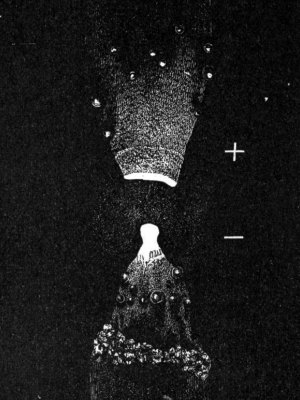CARBON-ROD-TECHNOLOGY
In carbon rods as applied in carbon arc sunlamps,
the binding forces that held together the carbon
atoms in their grid was relatively weak. Due to the
high temperature that comes with an arc discharge,
the rods would gradually get ionised and eventually
vaporise. The greatest loss of material took place at
the tip of the anode rod where the temperature was
at his highest level due to the never lasting
bombardment of electrons coming from the cathode.
A part of the ionised carbon atoms would sublimate
on the relatively cold cathode. The small crater in
the anode (+) and the complementary tip in the
cathode (-) caused by this process were typical for
a DC-operated carbon arc lamp whereby the speed
at which the anode burned away was almost twice
that of the cathode.


